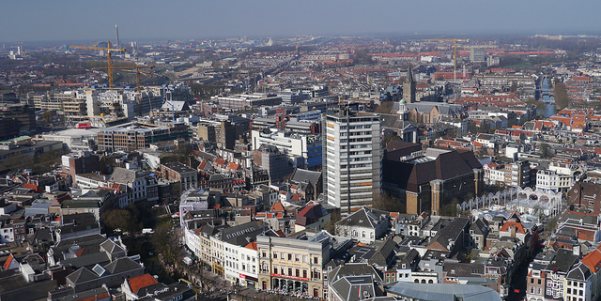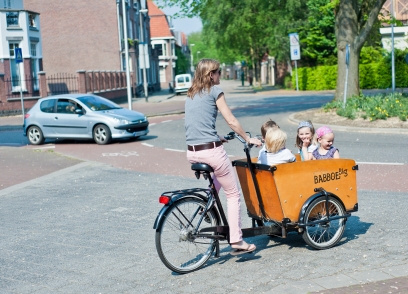At a PLAN-Boulder County forum on the evening of July 30, Kevin Krizek, professor of planning and design at CU-Boulder, suggested that Boulder supplement or replace its current set of ten American peer cities with five new peer cities in northern Europe as one of a series of actions to make our transportation system more “localized” and friendly to the environment. So Hello, Groningen! Good-Bye, Anne Arbor! (maybe).
Krizek titled his talk, “How Green is Boulder’s Land Use Transportation System? A Report on the State of the Community and Future Challenges.” At the end of his presentation, he donned his professor’s hat and gave Boulder a grade of “A” compared to most other cities in the U.S. But he only gave it a “C” compared to other cities in the world. Presumably those other cities are his proposed, new peer cities: Delft (Netherlands), Groningen (Netherlands), Munster (Germany), Odense (Denmark), and Utrecht (Netherlands). Krizek declared, “Boulder needs to change.”
Krizek observed that Boulder’s population doubles during the day. Thirty-seven percent of employees in the city live outside of Boulder County, and 70 percent live outside of the city limits, he said. He claimed that Boulder’s single-family homeowners are relatively wealthy and becoming more so. He asserted that only eight percent of Boulder’s single family homeowners can afford their houses based on traditional ratios of income to house price; and he noted that 32 percent of these homeowners do not have a mortgage (apparently a relatively high percentage). He claimed that it is more difficult to change the behavior of “people of wealth” than that of “people of income” with respect to transportation.
Krizek divided his sets of proposals to improve Boulder’s transportation system into “low-hanging,” “middle-hanging,” and “high-hanging fruit.” He commented that most of the low-hanging fruit has already been picked, and that “we are at the point of diminishing returns from laying down more infra-structure.” But, he asserted that one remaining low-hanging fruit is to “celebrate the art of travel.” He welcomed the possibility that alternate modes might become “cool” and that people at parties might discuss their bike routes to work and their equipment as commonly as their 401(k)s and the Broncos’ schedule. He remarked that, “A guilt strategy only goes so far.” Familiarity with and comparisons to Krizek’s proposed European peer cities might foster an alternative modes culture in Boulder.
Among his “middle-hanging fruit,” Krizek described:
- Introducing an “accessibility card” that could be used for B-Cycle, RTD, car-sharing and perhaps other systems.
- Improving transportation connections to the “L-towns” (Longmont, Louisville, Lafayette, Lyons) and promoting “strict land use” standards in them.
- Co-locating major employers, promoting density in employment centers, and allowing retail and other uses in them so that employees can get to and from work in buses and car pools and transact personal business nearby.
- Changing parking requirements. “Parking is a transportation planners secret weapon,” Krizek proclaimed and the most effective-way to alter people’s transportation mode choice decisions. He mentioned a planning and parking professor in Southern California named Don Shoup who has concluded that the optimum period of time in which drivers should search for parking is two and a half minutes. Krizek proposed removing parking minimums from Boulder’s land use code, establishing parking maximums for new developments and removing off-street parking limits. He observed that Copenhagen, Denmark, has been removing three percent of its parking space every year since 1969 and is considered by many observers to be a very pleasant place in which to work and live.
Of course, Krizek also revealed the “high-hanging fruit”:
- Decrease the dependence of public transportation funding on sales and use tax and instead pay for more of it by capturing the appreciation in land-values from transit-oriented development.
- Drastically reduce the use of cars to transport students and employees to and from school. He asserted that 25 million passenger-miles a year are accumulated by students and employees just in the Boulder Valley School District (BVSD). Krizek noted with approval, though, that BVSD has started to provide Eco-Passes to its employees.
- Increase residential development density, if policy-makers decide to make all or most of Boulder walkable. Krizek declared that ten dwelling units per acre is the minimum threshold for a walkable area. He showed a map of Boulder that depicted only two, relatively small areas in Boulder—one being the section that includes Williams Village—that meet the 10 units per acre standard. He clarified that he was not necessarily advocating such density, but just noting that it is considered a pre-requisite for “walkability.” He seemed to indicate that to achieve such density Boulder’s residential areas could be predominantly filled multi-unit buildings having three stories, which, he said, is the typical height of residential structures in Copenhagen.
- Gradually and significantly expand the Pearl Street Mall.
During his talk Krizek referred once to PLAN-Boulder County’s much acclaimed white paper “Does Dense Make Sense?” by remarking that it is “antithetical to those who have drunk the Kool-Aid and like compact cities.” The forum audience of about 30 people at Shine Restaurant included many transportation aficionados and seemed generally receptive to Krizek’s ideas.






 (8 votes, average: 3.50 out of 5)
(8 votes, average: 3.50 out of 5)